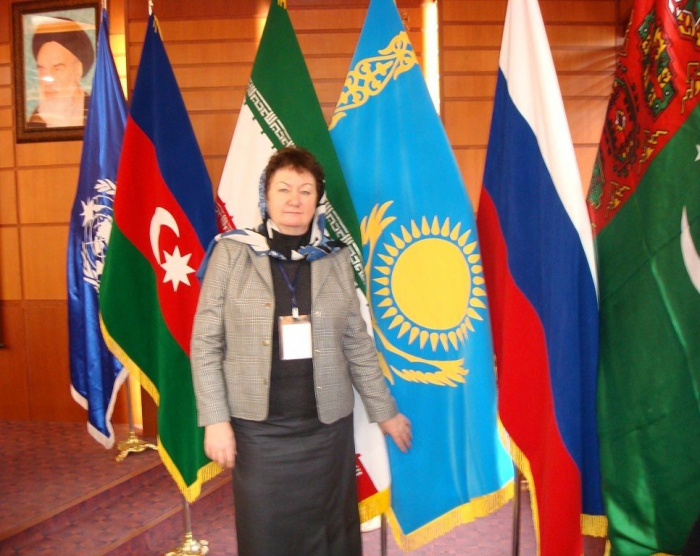According to the calculations by German and Dutch researchers, the water level drops by 6-7 cm in the Caspian Sea. At such a pace, the sea level will fall by 9-18 m, one-third of its area will dry up by the end of the century. European scientists believe the situation will cause several ecological and economic problems.
To comment on these predictions, AzVision.az interviewed the head of the Caspian Sea Hydrometeorological Research Department of the ‘Kazidromet’ State Institution of Kazakhstan, expert of the Technical Commissions on Marine Oceanography of the World Maritime Organization, and deputy editor-in-chief of ‘Hydrometeorology and Ecology’ journal, Natalia Ivkina.
- On what basis did German and Dutch researchers come to these conclusions?
- In their publications, scientists from Utrecht and Bremen Universities pay more attention to the significant increase of evaporation in the near decades, which will lead to the fast drop in the sea level. Many researchers, especially Russian scientists, think using only climate change data, German researchers do not consider the rainfall coming from the Mediterranean Basin. They do not consider the summer cyclones carrying huge masses of water to the Volga Basin. The Volga is the main river in the Caspian Basin and provides nearly 85% of its annual inflow. Although we predict a decrease in the water level in the future, and the observations indicate a drop in sea level, I believe their forecasts are extremely pessimistic and unlikely to become real.
- The tendency of water level drop in the Caspian Sea has been observed for several years. What are the reasons why?
- As the Caspian Sea is a closed water basin compared to other seas, the sea level bared long-term, annual and seasonal changes. Variation in sea level is driven by a volumetric change that reflects changes in the volume of water masses in the sea basin, are nearly the same size in any part of the sea, and are usually slow and relatively regular. The water level of the Caspian Sea has been falling since 2006. In 2021, its mark was -28.42 m on the Baltic System (BS), and in December 2021, it reached -28.55 m (BS). Between 2005 and 2021, the total sea level fell by 1.51 m. In addition, the intensity of the sea-level drop over the past year was 18 cm. During this period, the sea surface area was 23,000 square kilometers, half of which falls on the Kazakh part of the North Caspian Sea.
Over the last 15 years, there have been low levels of rainfall in the aquatorium of the Caspian Sea with intensive evaporation. The average water flow was pretty low due to a series of drought years in the Volga River basin. The main reason for this water shortage is global warming in the Northern Hemisphere.
- How long will the water level drop continue in the Caspian Sea?
- According to our forecasts, this tendency will continue in the coming decades. We have conducted studies on the impact of future climate change on the components of the water balance and the level of the Caspian Sea. We have used the catalog of terrestrial flows established under the Caspian Coordination Committee on Hydrometeorology.
The estimations indicated a tendency for a steady drop in the level of the Caspian Sea. That will be more obvious in the second thirty years of the 21st century. The level of the Caspian sea may reach -29, 4…- 29,6 m by 2030. You can find more detailed information about our research studies in the materials of the scientific conference on Climate Change in the Caspian Sea Region held on October 27-28, 2021 in an online format. Those materials are currently in preparation for publication.
- Is there any concrete climate forecast for the Caspian region for an exact period of time?
There is no such forecast for now. During the 4th session of the Coordinating Committee on Hydrometeorology and Pollution Monitoring of the Caspian Sea, the participants agreed to publish an Annual Bulletin to monitor the situation and climate change in the Caspian region. CASPCOM discussed the climate bulletin and its content during its 5th session too. Our scientists also conduct research studies on climate change of the Caspian Sea in Kazakhstan. Studies demonstrated that the average annual temperature growth rate has varied from 0.24 ° C to 0.43 ° C for a decade. Over the past 20 years, all stations in the Caspian region have recorded the majority of positive deviations from the long-term average. The annual precipitation averages are based on data collected by weather stations, and in general, on interannual variability.
- In your opinion, should the Caspian states take measures to raise the water level of the rivers flowing into the Caspian Sea?
- Caspian littoral countries - Azerbaijan, Russia, Iran, Turkmenistan, and Kazakhstan - should develop cooperation, conduct joint scientific research, and exchange forecasts and observational data. It is being implemented partially in the CASPCOM and Tehran Convention.
- How does the sea-level drop affect the fauna of the Caspian Sea?
- Decrease in the sea level negatively affects its ecosystem. Channel shallowing will lead to a reduction of spawning grounds, and an increase in salinity to a reduction in foraging grounds. A decrease in fish catches will create problems for fishing enterprises. Moreover, a drop in the level significantly complicates economic activities in the coastal and shallow water zones. Entities of port operations and maritime transport are especially prone to it.
More about: #CaspianSea
















































